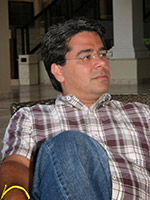The Reason I Hire MSR Alumni
HDT Global’s Julio Santos-Munné shares what he thinks differentiates Northwestern Engineering’s Master of Science in Robotics (MSR) students
Julio Santos-Munné (MS ‘96) has had a front-row seat to the evolution of the robotics industry.
Twenty-five years ago, he arrived at Northwestern University to pursue his MS in mechanical engineering. Santos-Munné wanted to pursue a medical robotic project, and he partnered with Professor Michael Peshkin to invent a “coordinated fluoroscopy” that coordinated two fluoroscopic images to establish accurate computer-based planning for a robotic-guided surgical procedure. That work would lead to Z-Kat Inc., Santos-Munné’s first startup.
 Since then, he’s held leadership roles at Cobotics, Kinea Design, and HDT Global, where today he is director of engineering for robotics.
Since then, he’s held leadership roles at Cobotics, Kinea Design, and HDT Global, where today he is director of engineering for robotics.
In his current role, Santos-Munné has been an avid supporter of Northwestern Engineering’s Master of Science in Robotics (MSR) program. He has hired multiple MSR alumni, and he is a frequent guest at the MSR Open House that showcases student projects.
Santos-Munné took a few minutes to share his thoughts on the robotics industry and what he thinks differentiates the MSR program.
What do you think is the biggest challenge facing the robotics industry today?
Oh boy, I don’t know that there is a simple answer to this question, but if I had to sum it up, I’d say that — even though we’ve come a long way – much more needs to be done to improve a robot’s ability to adapt and collaborate with other robots and/or people. Yes, you can program a robot to do many tasks – every day more than the previous – but we can’t yet transfer a robot from one assembly task to another seamlessly (or as seamlessly as you could do with a person). There is still quite a bit of programming, reconfiguring required, and costs incurred.
I also think that the sense of touch needs to be further developed into an effective sensing modality — like vision is becoming. A robot today can pick up an object, determine how much it weighs, its compliance, its temperature, but it can’t tell you what it was that it picked up by just touching it (twirling it between its fingers). So, tasks like reaching behind an object and feeling its way – blindly – to fasten a nut onto a screw, become very hard to do, unless of course you go back to “controlling the environment.” Note that a person can do this in their sleep.
What do you think makes the MSR program unique?
The reason I keep attending open houses and recruiting from the MSR program is because I know that I’ll be hiring a bright person with a passion for robotics/mechatronics who has enough relevant hands-on experience to be an immediate contributor to my engineering team. The fact that students pick their projects speaks to their interest and passion for robotics, and the fact that they have to develop it from scratch (whatever it may be) speaks to the experience they gain. They also develop these projects using the same tools that we as businesses are using to develop our products.
From your experience, what differentiates students who graduate from the MSR program?
There are other university programs that prepare students with a similar level of academic rigor and hands-on experience, but they have to be sought out. Graduates of the MSR will all have hands-on project development experience, so it makes my recruiting job much easier.
Having the open house is a great idea, as it gives recruiters the opportunity to not only converse with the student, but more importantly to see exactly what the student has done.

